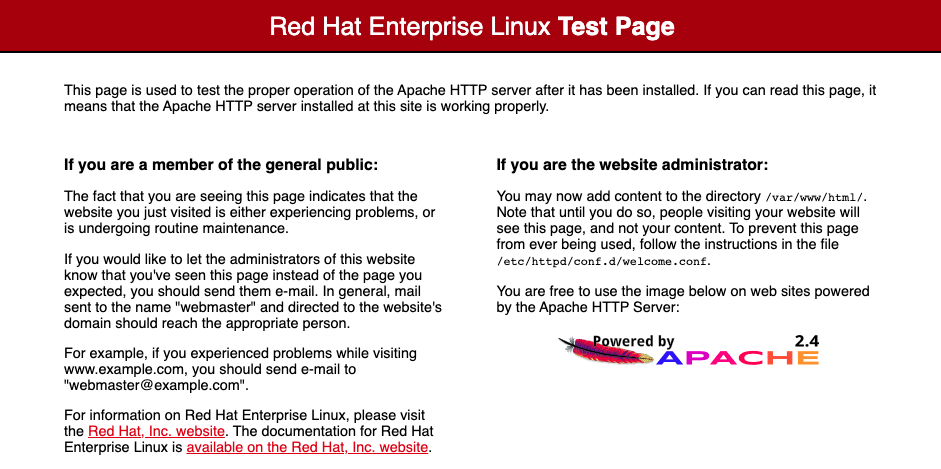Procedures
Integration procedures include:
-
Installing the HSM.
-
Installing the Security World Software and create the security world.
-
Installing the Apache HTTP Server.
-
Testing CHIL.
-
Configuring the Apache HTTP Server to use the HSM.
This chapter describes these procedures.
Installing the HSM
Install the HSM by following the instructions in the Installation Guide for the HSM.
We recommend that you install the HSM before configuring the Security World Software with your Apache HTTP Server.
Installing the Security World Software and creating the security world
To install the Security World Software and create the security world:
-
On the computer that you want to make the Apache HTTP Server, install the latest version of the Security World Software as described in the Installation Guide for the HSM.
We recommend that you uninstall any existing nShield software before installing the new nShield software. -
Create the security world as described in the User Guide, creating the ACS and OCS that you require.
Installing and configuring the Apache HTTP Server
To install the Apache HTTP Server:
sudo yum install httpd-tools openssl-libs mod_sslTesting CHIL
The nShield 12.40 Compatibility Package is required for the Cryptographic Hardware Interface Library (CHIL) plugin.
Because this version of the library needs a gen2 Security World, either an old world needs to be loaded, or the utility new-world-1240 needs to be used to create a suitable Security World.
To check that CHIL is working:
# export LD_LIBRARY_PATH=/opt/nfast/toolkits/hwcrhk/
# openssl engine -t chil
(chil) CHIL hardware engine support
[ available ]Configuring the Apache HTTP Server to use the HSM
Environment settings
For convenience:
export PATH=$PATH:/opt/nfast/binIn /etc/sysconfig/httpd add the line
LD_LIBRARY_PATH=/opt/nfast/toolkits/hwcrhkSet up Apache to use the CHIL library
Generate an embed key.
Ensure that the key files are output to your home directory or another working directory.
# generatekey embed
protect: Protected by? (token, module) [token] > module
size: Key size? (bits, minimum 1024) [2048] >
OPTIONAL: pubexp: Public exponent for RSA key (hex)? []
> embedsavefile: Filename to write key to? []
> testkey
plainname: Key name? [] > testkey
x509country: Country code? [] > [...]
x509province: State or province? [] > [...]
x509locality: City or locality? [] > [...]
x509org: Organisation? [] > [...]
x509orgunit: Organisation unit? [] > [...]
x509dnscommon: Domain name? [] > [...]
x509email: Email address? [] > [...]
nvram: Blob in NVRAM (needs ACS)? (yes/no) [no] >
digest: Digest to sign cert req with? (md5, sha1, sha256, sha384, sha512)
[default sha256] >
key generation parameters:
operation Operation to perform generate
application Application embed
protect Protected by module
verify Verify security of key yes
type Key type RSA
size Key size 2048
pubexp Public exponent for RSA key (hex)
embedsavefile Filename to write key to testkey
plainname Key name testkey
x509country Country code [...]
x509province State or province [...]
x509locality City or locality [...]
x509org Organisation [...]
x509orgunit Organisation unit [...]
x509dnscommon Domain name [...]
x509email Email address [...]
nvram Blob in NVRAM (needs ACS) no
digest Digest to sign cert req with sha256
Key successfully generated.
Path to key: /opt/nfast/kmdata/local/key_embed_6d5706...
Path to CSR: <CURRENTFOLDER>/embed_6d5706..._req
Path to self-cert: <CURRENTFOLDER>/embed_6d5706..._selfcertIn the same folder as the self-cert there will also be a file called testkey.
Copy the files into the Apache installation using the following commands (adjust to the values you get):
cp <CURRENTFOLDER>/testkey /etc/pki/tls/private/testkey
cp <CURRENTFOLDER>/embed_6d5706..._selfcert /etc/pki/tls/certs/testkey_selfcertIn /etc/httpd/conf.d/ssl.conf, set
SSLCertificateFile /etc/pki/tls/certs/testkey_selfcert
SSLCertificateKeyFile /etc/pki/tls/private/testkey
SSLCryptoDevice chilSwitch off SE Linux
If SE Linux is active, this might prevent Apache from loading our library. To switch it off:
setenforce 0Start the HTTP daemon
service httpd starthttps://<yourapacheserver> should work, and the certificate in the browser should show the information that was provided when creating the embed key above.
For example:

Figure 2.1 HTTPD successfully started
Test the connection
Test the connection with a command similar to:
openssl s_client -crlf -connect localhost:443 -CAfile testkey_selfcert.pem
openssl s_client -crlf -connect localhost:443 -CAfile <CURRENTFOLDER>/embed_6d5706.._
selfcertCheck the following messages and fields in the output:
-
CONNECTED(00000003)
-
depth
-
Certificate chain information
-
Server certificate information
-
Session-ID
-
Master-Key
-
TLS session ticket:
-
Verify return code: 0 (ok)
Example output:
# openssl s_client -crlf -connect localhost:443 -CAfile embed_6d5706..._selfcert
CONNECTED(00000003)
depth=[...]
verify return:1
---
Certificate chain
0 s:/C=[...]
i:/C=[...]
---
Server certificate
-----BEGIN CERTIFICATE-----
...
-----END CERTIFICATE-----
subject=[...]
issuer=[...]
---
No client certificate CA names sent
Peer signing digest: SHA512
Server Temp Key: ECDH, P-256, 256 bits
---
SSL handshake has read 1570 bytes and written 415 bytes
---
New, TLSv1/SSLv3, Cipher is ECDHE-...
Server public key is 2048 bit
Secure Renegotiation IS supported
Compression: NONE
Expansion: NONE
No ALPN negotiated
SSL-Session:
Protocol : TLSv1.2
Cipher : ECDHE-...
Session-ID: [...]
Session-ID-ctx:
Master-Key: [...]
Key-Arg : None
Krb5 Principal: None
PSK identity: None
PSK identity hint: None
TLS session ticket lifetime hint: 300 (seconds)
TLS session ticket:
...
Start Time: 1579086822
Timeout : 300 (sec)
Verify return code: 0 (ok)
---OCS protection
If OCS protection is required, create an OCS:
createocs -Q1/1 -Napacheocs -m 1Leave the OCS in the card reader and generate an embed key as in Set up Apache to use the CHIL library, but choose the protection to be token.
The steps to copy certificates about is the same as for module-protected keys.
When you are starting Apache, you will have to preload the OCS so that the key can be used without the web server having to load it:
preload -f /var/run/httpd/preload -c apacheocs /usr/sbin/httpd -e debug -XSoftcard protection
If softcard protection is required, create a softcard:
ppmk -n apachesoftGenerate an embed key as in Set up Apache to use the CHIL library, but choose the protection to be softcard.
The steps to copy certificates about is the same as for module protected keys.
When you are starting Apache, you will have to preload the softcard so that the key can be used without the web server having to load it:
preload -f /var/run/httpd/preload -s apachesoft /usr/sbin/httpd -e debug -X